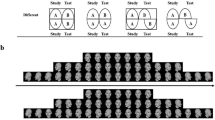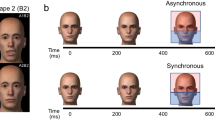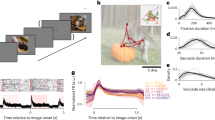Abstract
The aim of this study was to determine the extent to which the neural representation of faces in the visual cortex is viewpoint invariant. MEG was used to measure evoked responses to faces during an adaptation paradigm. Using familiar and unfamiliar faces, we compared the amplitude of the M170 response to repeated images of the same face compared to images of different faces. We found a reduction in the M170 amplitude to repeated presentations of the same face image compared to images of different faces when shown from the same viewpoint. To establish if this adaptation to the identity of a face was invariant to changes in viewpoint, we varied the viewing angle of the face within a block. In order to exert strict control over the viewpoint from which the face was viewed, we used 3D models recovered from single images using shape-from-shading. This makes the study unique in its use of techniques from machine vision in order to test human visual processes. We found a reduction in response was no longer evident when images of the same face were shown from different viewpoints. These results imply that the face-selective M170 response either reflects an early stage of face processing or that the computations underlying face recognition depend on a viewpoint-dependent neuronal representation.
Preview
Unable to display preview. Download preview PDF.
Similar content being viewed by others
References
Bruce, V., Young, A.W.: Understanding face recognition. Br. J. Psychol. 77, 305–327 (1986)
Haxby, J.V., Hoffman, E.A., Gobbini, M.I.: The distributed human neural system for face perception. Trends in Cognitive Science 4, 223–233 (2000)
Grill-Spector, K., Knouf, N., Kanwisher, K.: The fusiform face area subserves face perception, not generic within-category identification. Nature Neuroscience 7, 555–562 (2004)
Rotshtein, P., Henson, R.N., Treves, A., Driver, J., Dolan, R.J.: Morphing marilyn into maggie dissociates physical and identity face representations in the brain. Nat. Neurosci. 8, 107–113 (2005)
Gauthier, I., Tarr, M.J., Moylan, J., Skudlarski, P., Gore, J.C., Anderson, J.W.: The fusiform face area is part of a network that processes faces at the individual level. J. Cogn. Neurosci. (2000)
Hoffman, E.A., Haxby, J.V.: Distinct representations of eye gaze and identity in the distributed human neural system for face perception. Nat. Neurosci. 3, 80–84 (2000)
Allison, T., Puce, A., Spencer, D., McCarthy, G.: Electrophysiological studies of human face perception: I. potentials generated in occipitotemporal cortex by face and non-face stimuli. Cerebral Cortex 9, 415–430 (1999)
Liu, J., Harris, A., Kanwisher, N.: Stage of processing in face perception: an meg study. Nat. Neurosci. 5, 910–916 (2002)
Grill-Spector, K., Henson, R., Martin, A.: Repetition and the brain: neural models of stimulus-specific effects. Trends in Cognitive Science 10, 14–23 (2006)
Harris, A., Nakayama, K.: Rapid face-selective adaptation of an early extrastriate component in meg. Cerebral Cortex 17, 63–70 (2007)
Ewbank, M.P., Andrews, T.J.: Size-invariant, but viewpoint-specific adaptation of the n170 potential to faces. In: Proc. 12th Annual Meeting of the Organisation for Human Brain Mapping (2006)
Smith, W.A.P., Hancock, E.R.: Recovering facial shape using a statistical model of surface normal direction. IEEE Trans. PAMI 28, 1914–1930 (2006)
Kovacs, G., Zimmer, M., Banko, E., Harza, I., Antal, A., Vidnyanszky, Z.: Electrophysiological correlates of visual adaptation to faces and body parts in humans. Cereb. Cortex 16, 742–753 (2006)
Schweinberger, S.R., Huddy, V., Burton, A.M.: N250r: A face-selective brain response to stimulus repetitions. NeuroReport 15, 1501–1505 (2004)
Henson, R.N., Rylands, A., Ross, E., Vuilleumeir, P., Rugg, M.D.: The effect of repetition lag on electrophysiological and haemodynamic correlates of visual object priming. Neuroimage 21, 1674–1689 (2004)
Grill-Spector, K., Kushnir, T., Hendler, T., Edelman, S., Itzchak, Y., Malach, R.: Differential processing of objects under various viewing conditions in human lateral occipital complex. Neuron 24, 187–203 (1999)
Eger, E., Schweinberger, S.R., Dolan, R.J., Henson, R.N.: Familiarity enhances invariance of face-representations in human ventral visual cortex: fmri evidence. NeuroImage 26, 1128–1139 (2005)
Hancock, P.J.B., Bruce, V., Burton, A.M.: Recognition of unfamiliar faces. Trends in Cognitive Sciences 4, 330–337 (2000)
Andrews, T.J., Ewbank, M.P.: Distinct representations for facial identity and changeable aspects of faces in the human temporal lobe. NeuroImage 23, 905–913 (2004)
Wallis, G., Bulthoff, H.: Learning to recognize objects. Trends in Cognitive Sciences 3, 22–31 (1999)
Author information
Authors and Affiliations
Editor information
Rights and permissions
Copyright information
© 2007 Springer-Verlag Berlin Heidelberg
About this paper
Cite this paper
Ewbank, M.P., Smith, W.A.P., Hancock, E.R., Andrews, T.J. (2007). Testing Viewpoint Invariance in the Neural Representation of Faces: An MEG Study. In: Mele, F., Ramella, G., Santillo, S., Ventriglia, F. (eds) Advances in Brain, Vision, and Artificial Intelligence. BVAI 2007. Lecture Notes in Computer Science, vol 4729. Springer, Berlin, Heidelberg. https://doi.org/10.1007/978-3-540-75555-5_6
Download citation
DOI: https://doi.org/10.1007/978-3-540-75555-5_6
Publisher Name: Springer, Berlin, Heidelberg
Print ISBN: 978-3-540-75554-8
Online ISBN: 978-3-540-75555-5
eBook Packages: Computer ScienceComputer Science (R0)




